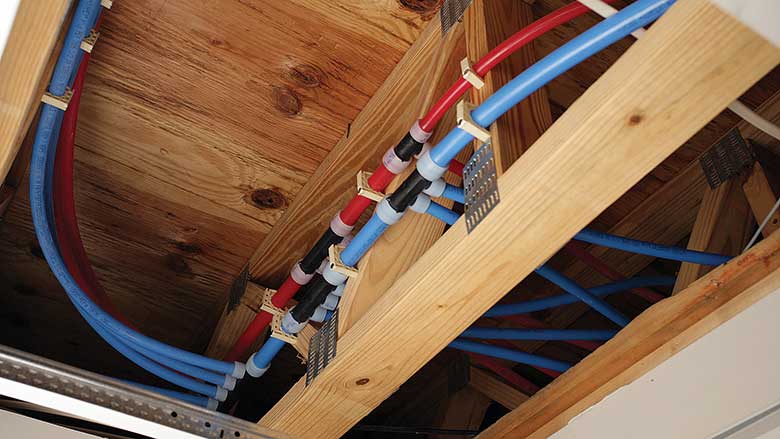PEX pipes have become a popular choice for homeowners due to their flexibility, durability, and affordability. And knowing the lifespan of pipes is crucial for making informed choices regarding plumbing installations and repairs.
So, how long does PEX pipe last? PEX pipes offer exceptional durability and longevity, boasting a lifespan of up to 50 years. Factors affecting the lifespan of installations include installation quality, water quality, and temperature and pressure. And maximizing the lifespan of PEX pipes requires meticulous installation and maintenance.
However, in this informative article, discover the key factors affecting PEX pipes’ longevity and learn effective strategies to increase their lifespan.
How Long Does PEX Pipe Last?
PEX pipes have been around for over 50 years, but many homeowners and contractors still wonder how long they last. It relies on installation quality, water quality, temperature, pressure, chemical exposure, UV exposure, and age.
On average, PEX pipes can last anywhere from 20 to 50 years, with some manufacturers offering up to 25 years of warranties. Let us look into this table that elaborates on the factors that impact the longevity of PEX pipes.
| Factors | Impact on Lifespan |
| Quality of installation | Proper installation can ensure up to 100 years of lifespan |
| Water quality | Can shorten lifespan due to corrosion or scaling |
| Temperature and pressure | High temperatures and pressures can shorten lifespan, while low temperatures and pressures can cause damage |
| Chemical exposure | Can degrade the pipes and shorten the lifespan |
| UV exposure | Can cause degradation and shorten the lifespan |
| Age | PEX pipes can last up to 50-75 years but may need replacement due to aging |
Regular maintenance and inspection can help identify issues and prolong the lifespan of the pipes.
Unique Features You Should Know About PEX Pipe
Discover the exceptional characteristics of PEX piping that set it apart from other options:
Flexible
One of the most significant advantages of PEX piping is its flexibility. Due to its flexibility, this material can bend and curve around obstacles without couplings or fittings.
Corrosion-resistant
Unlike copper pipes, PEX pipes are resistant to corrosion, which is caused by minerals and chemicals in the water. Hard water-resistant properties make these products a top choice for areas with high mineral content in water.
Freeze-resistant
PEX pipes can expand and contract, making them resistant to freezing. If the water inside the pipe freezes and expands, the pipe can stretch without breaking. This makes it an ideal choice for areas with extreme temperatures.
Energy-efficient
PEX pipes have a smooth surface that reduces resistance to water flow, which means that less energy is required to pump water through the pipes. Lowering energy bills is one of the benefits of this outcome.
Low noise transmission
PEX pipes have a natural noise-dampening property that reduces the noise of flowing water. Choose these for multi-level structures or spaces requiring noise reduction.
Longevity
PEX pipes have a longer lifespan than traditional copper or PVC pipes, typically lasting for 20-50 years, depending on the quality of the installation and maintenance. This piping is a top-notch option for plumbing applications due to its exceptional features.
Factors That Affect the Lifespan of PEX Pipes
Discover the crucial factors that impact the longevity of PEX pipes, according to multiple sources:
Installation Quality
To ensure that PEX pipes last a long time, excellent installation is essential. Avoiding common mistakes such as kinking, over-bending, improper connections, and improper support can be achieved through the implementation of proper installation techniques and practices.
For optimal results, it is recommended to have certified experts carry out the installation of PEX pipes in strict adherence to the manufacturer’s installation instructions. Here is a video elaborating on the proper way of PEX pipe installation.
Water Quality
The PEX pipes’ longevity may be significantly impacted by the quality of the water passing through them. Besides, the corrosion and degradation of pipe material can be caused by excessively acidic or alkaline water over time.
Regular water testing and installation of a water softener or pH neutralizer are highly recommended. It will safeguard PEX pipes from potential water quality problems.
Temperature and Pressure
PEX pipes have a specified range of acceptable temperatures and pressures, and going above these limitations might reduce their longevity. High and low temperatures may break and split pipes. Protect your pipes from temperature fluctuations to prevent costly repairs.
Pipes can burst due to high pressure and collapse due to low pressure. For optimal performance, it is highly advised to install PEX pipes with the correct rating for their intended use. So it will steer clear of exposing them to extreme temperatures and pressures.
This will help prevent any potential issues related to temperature and pressure.
Chemical Exposure
Exposed PEX pipes may deteriorate and lose their structural integrity.
PEX Pipe Damage: Chemicals to Avoid Chlorine, acids, and certain solvents are among the common chemicals that can harm PEX pipes.
Protect your plumbing system by avoiding these substances. Protecting PEX pipes from chemical exposure is crucial for their longevity and performance.
To ensure this, it is advisable to minimize their exposure to chemicals and use suitable barriers or coatings during installation is advisable.
UV Exposure
UV exposure has the potential to harm PEX pipes, making them brittle and more likely to shatter. Protecting PEX pipes from UV exposure is crucial for their longevity.
To achieve this, it is advisable to install them in areas shielded from sunlight or use UV-resistant coatings or sleeves.
Age
Due to their limited lifetime, PEX pipes ultimately need to be replaced. Factors affecting the lifespan of PEX pipes include installation quality, water quality, temperature and pressure, chemical exposure, and UV exposure.
PEX pipes may exhibit signs of aging, such as diminished water pressure, discoloration, leaks, and cracks. Maintaining a safe and efficient plumbing system requires replacing PEX pipes that have completed their life with new pipes that meet building requirements and standards.
To ensure the durability of PEX pipes, it is crucial to prioritize appropriate installation, consistent upkeep, and thoughtful evaluation of elements such as water quality, temperature, pressure, chemical exposure, and UV exposure.
Maintenance Of Pex Pipes for Longevity
PEX pipes require regular maintenance to ensure their durability and longevity. Discover effective ways to maintain your PEX plumbing system with these helpful tips.
● Regular inspection
Check the pipes often for any indications of leaks or damage. Inspect pipes for signs of discoloration or bulging. Inspecting joints and connections for potential leaks is crucial.
● Avoid high temperatures
PEX pipes are sensitive to high temperatures. So keep your items away from direct sunlight and heat sources to prevent damage. Insulate your installation if you anticipate high temperatures in the area to ensure optimal performance.
● Protect from chemicals
PEX pipes can be damaged by exposure to chemicals, including acids, solvents, and cleaners. Rinse thoroughly after using any chemicals near them to avoid damage.
● Check water quality
Poor water quality can also damage PEX pipes. Regularly testing your water quality is crucial for maintaining a healthy and safe environment. Addressing concerns ensures high-quality water. Protect your water and health now.
● Prevent freezing
PEX pipes can be damaged by freezing temperatures. Hence, prevent freezing in cold weather by insulating pipes in chilly areas and maintaining water flow.
● Keep clean
Keep the pipes clean to prevent buildup and blockages. System flushing is an essential maintenance task to eliminate any sediment or debris buildup. And it is recommended to perform this task regularly.
Ensure the longevity of your PEX plumbing system and avoid expensive repairs or replacements in the future by adhering to these maintenance tips.
Conclusion
Discover the factors that can affect the lifespan of PEX pipes, including installation quality, water quality, temperature and pressure, chemical exposure, UV exposure, and age. PEX pipes offer a long-lasting and dependable plumbing solution with appropriate installation and upkeep.
To guarantee the durability of your PEX pipes and prevent any potential problems, it is crucial to consider these factors. Discover the benefits and drawbacks of utilizing PEX pipes for your plumbing requirements. Consult a skilled plumber to determine if this is the optimal choice for your property.

